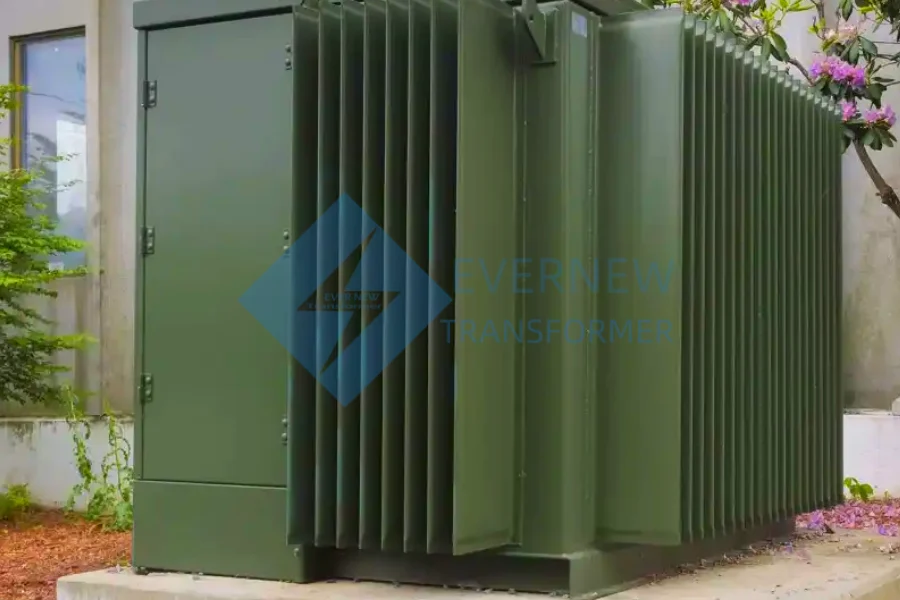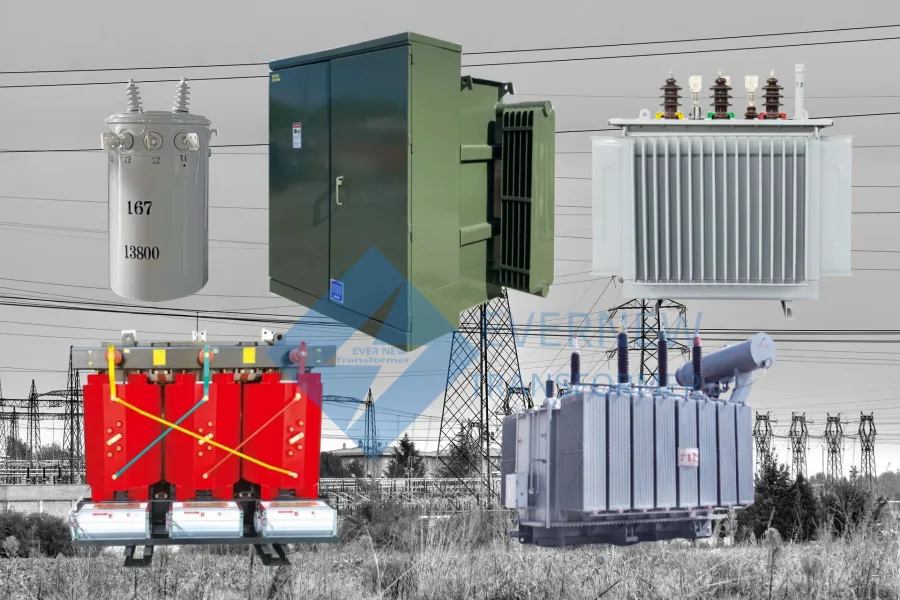Transformers are essential in modern electrical systems, playing a crucial role in adjusting voltage levels to meet specific operational needs. In power distribution networks, power distribution equipment transformers ensure that electricity generated in power plants is efficiently and safely delivered to end-users, whether for residential, commercial, or industrial purposes. Evernew Transformer, a leading transformer manufacturer in China, produces high-quality power distribution equipment transformers designed to meet global power distribution needs. In this blog, we will explore the two primary types of transformers—power transformers and distribution transformers—highlighting their differences, uses, and the significant role they play in power distribution systems.
What Is a Power Transformer?
A power transformer is primarily used to transmit electrical power over long distances. It operates by stepping up or stepping down the voltage to match the requirements of the transmission network. These transformers typically handle high voltage levels ranging from 756kV down to 11kV. Power distribution equipment transformers, such as power transformers, are found in power stations and transmission substations, where they regulate the voltage to ensure efficient long-distance transmission.
Due to their higher MVA (Mega Volt-Ampere) ratings, power distribution equipment transformers are designed to operate at full load with minimal fluctuations, ensuring that large amounts of electricity can flow with minimal loss. These transformers are often located in remote areas such as substations, far from consumers, to minimize space and increase efficiency.
Read More:Top 10 Power Transformer Manufacturers In The World
What Is a Distribution Transformer?
In contrast to power transformers, distribution transformers are designed to reduce voltage levels to safe, usable levels for homes, businesses, and industrial facilities. Power distribution equipment transformers of this type typically operate at voltage levels between 33kV and 430V. These transformers are installed much closer to the end-user and play a key role in making electricity safe and accessible for everyday use.
Distribution transformers often serve multiple residential or industrial users and are vital in reducing the voltage to the levels required for equipment to operate safely and efficiently. For instance, homes in most countries receive a 120V or 240V service, while larger industrial facilities might require higher voltage levels such as 480V or 600V, depending on their power needs.
Read More:Electrical Substation Transformer Deep Dive
Key Differences Between Power and Distribution Transformers
While both power distribution equipment transformers and distribution transformers serve to adjust voltage levels, they have distinct differences in terms of design, use, and installation:
- Voltage Range: Power distribution equipment transformers handle higher voltage levels, typically ranging from 400kV to 33kV, while distribution transformers handle lower voltage levels, generally between 33kV and 430V.
- Applications: Power distribution equipment transformers are used in high-voltage transmission networks, while distribution transformers are used in low-voltage distribution networks.
- Size and Design: Power distribution equipment transformers are significantly larger in size, often requiring specialized facilities for installation and operation. Distribution transformers, however, are smaller and often placed in urban or suburban areas closer to end users.
- Load Handling: Power distribution equipment transformers generally operate at full load with minimal fluctuation, whereas distribution transformers can experience more significant load changes based on demand patterns.

The Critical Role of Transformers in Power Distribution Systems
Power distribution equipment transformers are indispensable for the functioning of power distribution systems. Here’s why:
1. Voltage Regulation
Power distribution equipment transformers adjust the voltage levels at various points in the network. By stepping up voltage for long-distance transmission and stepping it down for consumer use, these transformers reduce the risk of power losses. For instance, stepping up the voltage for transmission lowers the current, thereby reducing losses due to resistance (I²R losses) in the transmission lines.
2. Energy Efficiency
High-voltage transmission is more energy-efficient than low-voltage transmission. By using power distribution equipment transformers to step up voltage for long-distance transmission, the energy losses in the transmission lines are minimized. This leads to cost savings in infrastructure and improves the overall efficiency of the electrical grid.
3. Safety and Reliability
Power distribution equipment transformers play a vital role in maintaining safety by lowering the voltage to levels that are safe for consumer use. By ensuring that the voltage is properly regulated, power distribution equipment transformers help protect electrical appliances, machinery, and end-users from potential hazards caused by electrical surges or voltage imbalances.
4. Flexibility in Design
Power distribution equipment transformers provide flexibility in the design of power distribution networks. Depending on the load requirements and geographical conditions, these transformers can be tailored to meet specific needs, whether for residential, commercial, or industrial purposes.
5. Integration of Renewable Energy
As the world shifts toward renewable energy sources, such as solar and wind, power distribution equipment transformers are playing an increasingly important role in integrating these variable energy sources into the power grid. By managing voltage fluctuations and ensuring stable power supply, power distribution equipment transformers facilitate the smooth integration of renewable energy into the national grid.
Learn More:The Complete Guide to High Voltage Transformers
Types of Distribution Transformers
There are several types of distribution transformers, each designed to meet specific power needs:
- Single Phase Transformers: Typically used for smaller residential applications with loads below 100 kVA.
- Three Phase Transformers: Designed for industrial and commercial applications with higher power requirements, generally exceeding 100 kVA.
- Dry Type Transformers: These dry type transformers are used in areas where fire safety is a priority. They are more compact and require less maintenance compared to oil-filled transformers.
- Oil Immersed Transformers: Suitable for heavy industrial applications that require high voltage and current capacity, these transformers use oil for cooling and insulation.
Get Free:What is a power plant transformer
Benefits of Using Distribution Transformers
Using high-quality power distribution equipment transformers brings several advantages:
- Improved Power Quality: Power distribution equipment transformers regulate the voltage to ensure a consistent and reliable power supply to consumers.
- Energy Savings: By reducing transmission losses and efficiently distributing power, power distribution equipment transformers help save energy and reduce costs.
- Enhanced Equipment Life: Stable voltage ensures that electrical devices and machinery operate within their designed parameters, thereby extending their lifespan.
- Safety Assurance: By lowering the voltage to safe levels, power distribution equipment transformers reduce the risk of electrical accidents and equipment failure.
Learn More:2000 KVA 33KV Oil Type Power Distribution Transformer
Conclusion
Transformers are the backbone of modern electrical distribution systems, ensuring that electricity generated at power plants reaches consumers efficiently and safely. Evernew Transformer, with its expertise in manufacturing high-quality power distribution equipment transformers, plays a critical role in this process. Whether for residential, commercial, or industrial applications, Evernew’s power distribution equipment transformers are designed to deliver reliable, energy-efficient solutions that meet the diverse needs of the global power distribution market.
Understanding the roles and benefits of power distribution equipment transformers is essential for appreciating the intricate design of power grids that power our homes, businesses, and industries.

